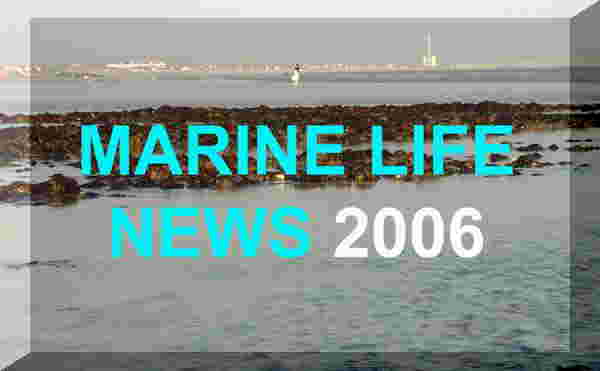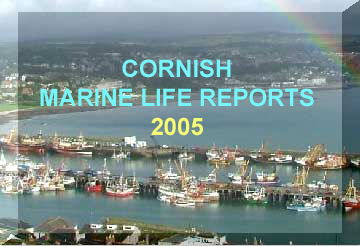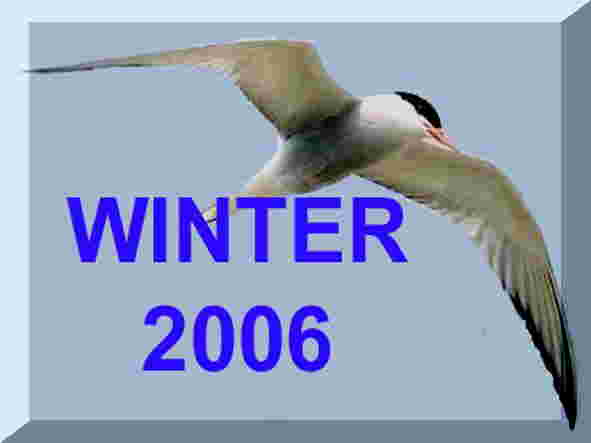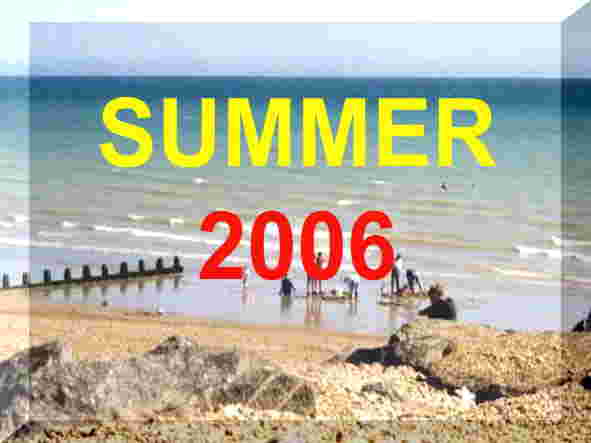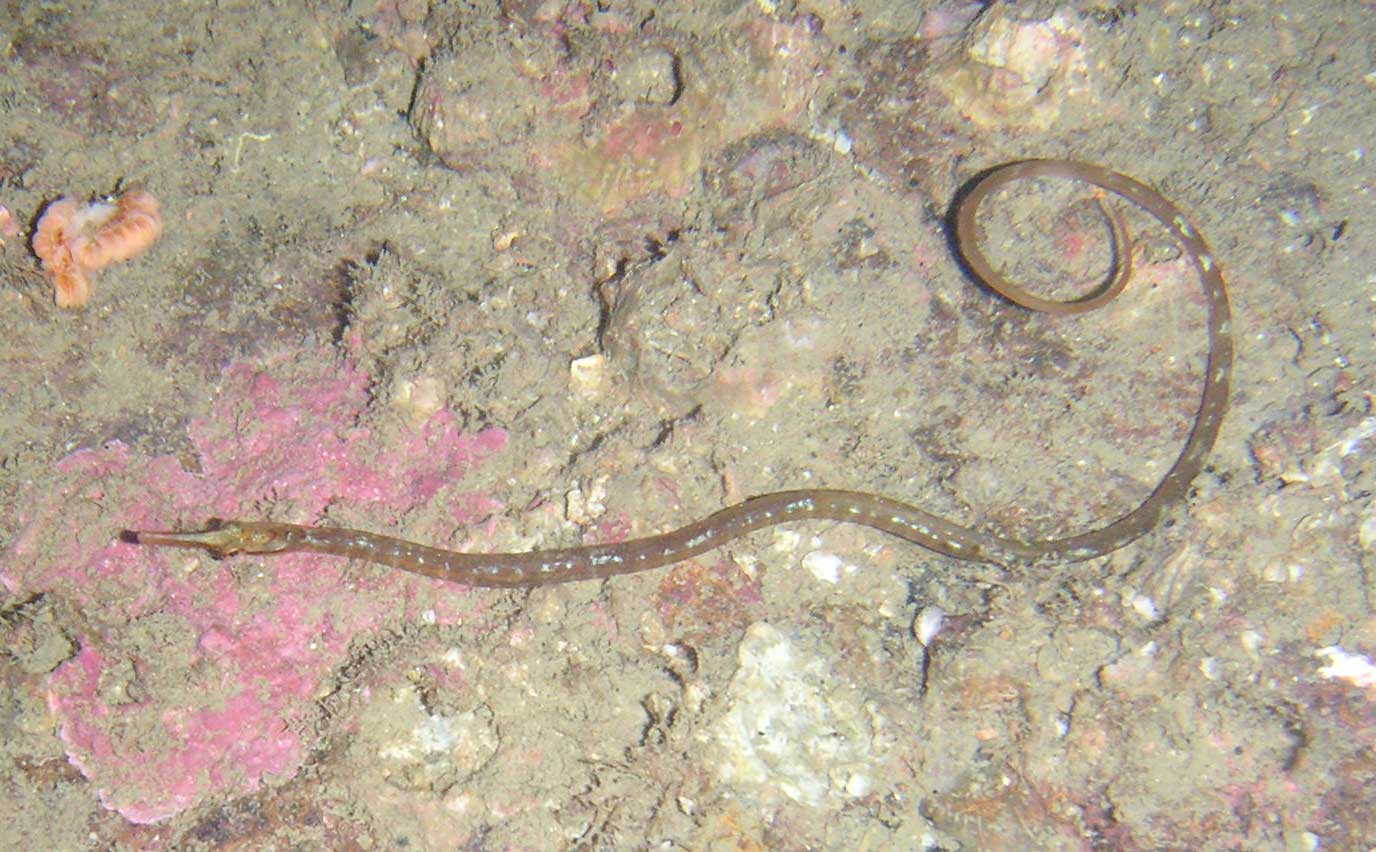LATEST
NEWS:
29
March 2006

The
peanut worm (sipunculid)
Sipunculus
nudus which was dug up by a bait digger
in Belle
Greve Bay on Guernsey's east coast, just north of St.
Peter Port. The animal was about 132 mm long and weighed 33 grams.
Of course, with the extended
introvert
it would be longer. It was quick to bury itself.
The
bait digger revealed on the same stretch of beach the echinoderms
Echinocardium
cordatum, and Leptosynapta
inhaerens and the bivalves Ensis
siliqua
and Dosinia lupinus.
14
March 2006

A Deal
Fish, Trachipterus
arcticus, was captured in a trawl
(by
Swedish trawler GG 348) at a depth of 200
metres in the northern Skagerrak off the south coast of Norway. The fish
weighed 12 kg and was measured with a total length of 177 cm. The
photograph above shows Swedish fishmonger Svante
Wedin with the elongate fish.
The
Deal
Fish is a
rare
deep water ribbon-fish with only a handful of North Sea coast reports of
this fish on record.
Most records have been in surface trawls or washed up dead on the beach.
This fish swims vertically in the water rising towards the surface with
the deep water plankton and their predators at night and descending during
the day. It feeds
on squids and small fishes.
Irish
Captures (Message)
26
February 2006
A
two metre long Deal Fish,
Trachipterus
arcticus, was reported caught by 16
year old angler Vibeke Thomasson at
Sørevågen, Utsira, Norway. The full report includes a photograph
showing the red dorsal fin.
Full
Report
Another
1993 Report (in Swedish)
25
February 2006
An
eel-like Red Band Fish, Cepola
rubescens, was discovered at the wave-break
as the sea splashed against the shore at Highcliffe, Dorset. The fish was
thrown back into the water and it was seen to swim off.
NB.
There infrequently recorded fish lives in burrows offshore and is rarely
seen with occasional live specimens seen out of its normal habitat when
its burrows are destroyed by gales and other disruption. It may not be
as uncommon as the few records indicate because its habitat means that
it is rarely seen alive. There have been even fewer records of this fish
being caught on an angler's line.
BMLSS
Red Band Fish (under construction)
24
February 2006
An
oiled and very old and worn Grey Seal,
Halichoerus
grypus,
was washed up on the rocky shore at Cuckmere Haven (near the Seven Sisters),
East Sussex. It was at the end of its life span and was euthanised.
NB:
Grey
Seals are almost unknown off Sussex, where
the Common Seal, Phoca
vitulina,
is only occasionally seen.
BMLSS Seals
Seal
Conservation Society
Marine
Life of Sussex News
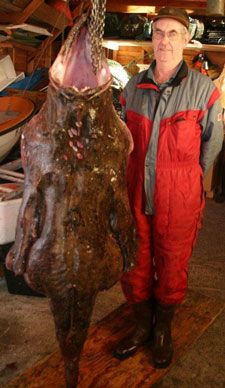 |
21
February 2006
A
new record weight Angler Fish,
Lophius
piscatorius, weighed in at 78 kg with
a total length of 164 cm, was captured in a net by Øystein
Øye, from off Norway.
|
15
February 2006
Another
Sperm
Whale, Physeter catodon,
was spotted near North Shore Road, Skegness
(Lincolnshire) on the North Sea coast during the morning high tide. It
was clear that it was dead after the tide receded.

Head
of the Sperm Whale on Skegness Beach
Photograph
by Karla
Ryder (Wymeswold)
The
Natural
History Museum took photos and limited samples of two dead Sperm
Whales, Physeter catodon,
in the Wash. Paul Jepson
visited the one at Skegness, quite decomposed,
a male, 14 metres in length. This means at least four Sperm
Whales have been washed up on the East Anglian
coast of Britain in February 2006.
BDMLR
Forum Extra Information
Skegness
Whale Report
Skegness
Today
UK
Cetnet (Yahoo Group)
BMLSS
Cetacea
It is the tenth anniversary
of the Sea Empress Tanker spillage at Milford Haven.
British
Oil Spills
13
February 2006
A Tarpon,
Megalops
atlanticus, was captured off
the Asturias coast (Spain).
This
is a large, western Atlantic, beautiful, silvery fish that reach up to
250 cm and weigh up to 161 kg. Reports from off the European coast are
unusual. There are no further details of the capture.
Report
and Photograph by Juan Carlos
on
the defunct Marine Wildlife of the North-east Atlantic Ocean Smart
Group
12
February 2006

Bass
with a blunt head
Photograph
by David Wilkinson
(Technical
Officer, Sea
Fisheries, Commerce & Employment
Department,
Guernsey)
This
most extraordinary looking Bass,
Dicentrarchus
labrax, was caught off the coast of Guernsey,
tagged and returned to the sea. Its blunt head looks like that of the Pagrus
Sea Bream and several other fish. This Bass
weighed an estimated 4.5 kg.
BMLSS Bass
4
February 2006
A
ten metre long Sperm Whale, Physeter
catodon, became stranded as
the tide receded on the Humber estuary mud off Kilnsea,
on Spurn Point,
East Yorkshire. It was first spotted alive at about 10:00
am blowing in the shallow water.
It quickly died as it was left clear of water on the low tide at 3:00
pm.
UK
Cetnet (Yahoo Group)
Organisation
Cetacea
BMLSS
Cetacea
2
February 2006
Over
fifty Common Dolphins, Delphinus
delphis, were bow riding our vessel with
four Fin Whales, Balaenoptera physalis,
four
miles south-west of Dodman Point (above Mevagissey),
south Cornwall.
30
January 2006
The
Bottle-nosed
Dolphin, Tursiops truncatus, that
visited Maryport Harbour, north-west
England, was finally released into the open sea. A team led by British
Divers Marine Life Rescue (BDMLR) successfully captured the animal,
assisted with a veterinary examination and then released the animal offshore,
where it was joined by two other dolphins of the same species, before strongly
swimming off to safety.
First
Report
BMLSS
Cetacean Reports 2006
28
January 2006
Thousands
of dead specimens of the Common Starfish,
Asteria
rubens, were washed up on the beach about a mile and a half to
the north of Tywyn
on the Cardigan Bay coast of north-west Wales.
There seem to be various interpretations of these mass strandings, including
winter storms and changes in water temperature.
BMLSS
Echinoderms
21
January 2006
A
Boar
Fish, Capros aper,
is washed up alive on at
Branksome
Chine, Dorset (near Bournemouth). It was thrown back in the sea but
it may get washed up again.

This
attractive deep water fish is very occasionally washed up alive or found
in rock pools and very occasionally caught by
anglers.
NB:
Although very tricky to keep and only recommended for advanced
marine Aquarius's' these fish make fascinating aquarium fish.
BMLSS
Boar Fish
Wet
Thumb (Marine Aquarium Study)
 A
three metres long White-beaked
Dolphin, Lagenorhyncus albirostris,
was washed up dead on the north Scotland mainland
coast, Caithness. It appeared as though it was a fishing capture and it
had been gutted to make it sink. Pods
of forty or so of these dolphins have been seen before off the Scottish
coast.
A
three metres long White-beaked
Dolphin, Lagenorhyncus albirostris,
was washed up dead on the north Scotland mainland
coast, Caithness. It appeared as though it was a fishing capture and it
had been gutted to make it sink. Pods
of forty or so of these dolphins have been seen before off the Scottish
coast.
The
Gruesome Gallery
Whales
& Dolphins in British Seas (by Steve Savage)
BMLSS
Cetacea
A six
metres long Basking Shark, Cetorhinus
maximus, was spotted by the Amethyst
fishing vessel heading in the direction of the Lizard off the south-west
of Cornwall. This appears to be the a very
early winter sighting and the first of the year.
BMLSS
Basking Sharks
20-21
January 2006
A
four tonne 5.8
metres long immature female Northern
Bottle-nosed Whale,
Hyperoodon
ampullatus, swam up to central London
and was seen as far upstream as Lambeth
Bridge, Westminster, (within sight of the Houses of Parliament). Three
adult whales were spotted east of the Thames Barrier the day before and
at 8:30 am a
man on a train spotted a whale in the Thames out of the train window. Rescue
attempts by British Divers
Marine Life Rescue (BDMLR) and the authorities are being directed to
persuading the whale to reverse direction and swim back out to sea and
to avoid any further collisions with boats. This is the first time a whale
had been seen so far upstream since records began in 1913.
On
the second day,
the whale looked in a poor condition and showed no sign of returning to
the open sea. A decision was taken (by
the BDLMR and authorities) to make an improvised
pontoon,
crane the whale on to it and tow the unfortunate sea mammal back out to
the Thames estuary. The prognosis was poor. The
whale died at 7:00
pm.
BDMLR
Report & Chronology
BDMLR
Press Release
Tidal
notes at London Bridge: High: 6 metres, Low: 1.3 metres (low about midday)
BDMLR
Forum
BDMLR
News Releases on Forum
BMLSS
Cetacean Reports 2006
UK
Cetnet (Yahoo Group)
|
? What
to do if you find a stranded whale or dolphin ?
|
If
you find a LIVE stranded or injured whale or dolphin on the beach you must
send for help QUICKLY. A whale or dolphin stranding is an emergency and
the speed of response by a professional rescue team is perhaps the most
crucial factor in determining whether or not an animal can be returned
to the sea alive.
EMERGENCY
NUMBERS FOR LIVE CETACEAN STRANDINGS
|
ENGLAND
|
WALES
|
SCOTLAND
|
|
0300 1234
999
|
0300 1234
999
|
0131 339
0111
|
|
CORNWALL
|
JERSEY
|
GUERNSEY
|
|
0845 201
2626
|
01534 724331
|
00 44 1481
257261
|
LINK
TO THE STRANDINGS PAGE
16-17
January 2006
Twenty
four egg cases of the endangered
Skate, Dipturus
(=Raja)
batis,
were discovered on the Sandside shore
near the Dounreay
nuclear power plant, Caithness, west of Thurso and Scrabster
Harbour and John
o'Groats on the northernmost coast of mainland Scotland, the first
records reported to the Shark
Trust and the first records on the
mainland Scotland since these egg case occurrences have been recorded.
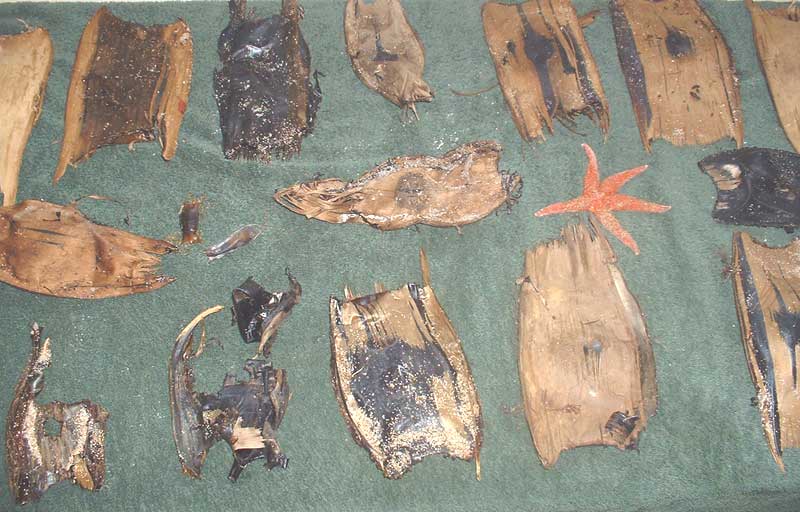
Egg
Cases of the Common Skate
The
egg cases measured between 23 to 28 cm long and 13 to 16 cm wide in a dried
state and the first seventeen were discovered in a 15 minute along the
beach.
When
the egg cases are placed in water they expand
in size.
 Shark
Trust Eggcase Hunt
Shark
Trust Eggcase Hunt
Caithness
Eggcase Walk
Report
by Paula Gent with photographs
by Davey Benson
Egg
Capsules of Rays & Sharks (Link to the Web Pages)
BMLSS
Mermaid's Purses
January
2005 Report
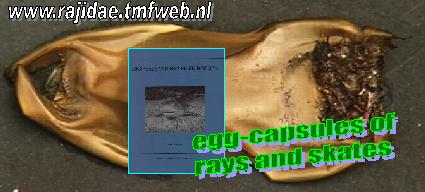
BMLSS
Shark & Ray News
16
January 2006
A
bright orange Red Band Fish,
Cepola
rubescens, was discovered alive but
in a moribund state in a rockpool on the shore
of Pevensey Bay in East Sussex. This fish is rarely recorded as it lives
in burrows in the sea bed offshore. This is one fish that has been discovered
more often since we have been recording its occurrence and it seems quite
widespread around the coasts of the British Isles.
Report
by John Cook
January
2006
Large
growths of an invasive species of a didemnid ascidian (sea squirt) called
Didemnum
sp.
may* have reached
the east coast of Ireland. It appears that large gelatinous growths
of a didemnid are appearing practically all around the world and have now
cropped up off the north European coasts as well as New Zealand and large
parts of the United States of America. These colonial tunicates are regarded
as a nuisance and one of many fouling organism species that attach to boat
hulls, fishing gear, harbour wharves etc.
Woods
Hole Science Center Information
Liz
Sides, from Duchas in Ireland says that one
of her tunicate taxonomic friends has found what appears to be a large
non-native Didemnum sp
growing prolifically in a marina on the Irish east coast. (*The
identification has not been confirmed yet.)
7
January 2006
The
Snake
Pipefish, Entelerus aequoreus,
photographed at a depth of 25 metres in Scapa Flow in the Orkney Isles
near the wreck of the SMS Koln. There were three of these fish seen.
NB:
These pipefish have been caught by Puffins
instead of their normal food of Sand-eels.
The fish might be commoner this year, but more likely the Sand-eels
populations have collapsed causing starvation amongst the Puffin
chicks.
Report
BMLSS
Pipefish
6
- 30 January 2006
A
friendly
Bottle-nosed Dolphin,
Tursiops
truncatus, visited Maryport
Harbour, Cumbria, on the Solway estuary in north-west England. Fishermen
say the dolphin, nicknamed 'Marra',
has been following them off Workington since summer and has always been
on its own. Experts believe he may have followed fishing boats into the
harbour. It has stayed around in the harbour for the month of January,
but although it is feeding, there are fears that there is insufficient
food of live fish in the harbour to sustain a large mammal.
Sea
Watch Foundation News
BMLSS
Cetacea
Unfortunately,
this dolphin was discovered dead on the beach at in Skinburness,
Cumbria, on 20 December 2006.
1 January
2006
Ormers,
Haliotis
tuberculata, with a minimum shell
length of 80 mm can be legally collected from the shores of Guernsey.

I discovered
an Ormer of shell
length 11.75 cm on 18 October 2005
on the
shore
at La Valette on Guernsey's east coast - south of St. Peter Port. I wanted
to find out if this Ormer
was still under the same rock. I was not disappointed. This is the second
time I have found an Ormer
in the autumn which has remained under the same rock through to the New
Year. I did not collect it but hope it survives the Ormer
collecting season which continues during large spring tides until the end
of April.
Rockpooling
in Guernsey
Magic
Map now has a Coastal and Marine Resource Atlas

The
Marine Wildlife of the NE Atlantic Forum
PLEASE
JOIN


